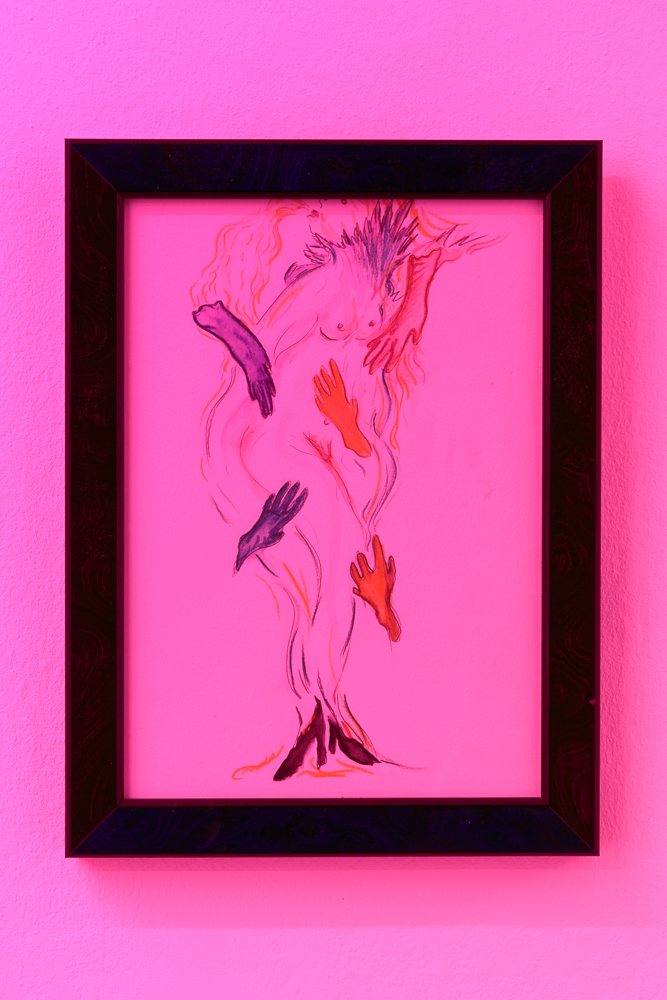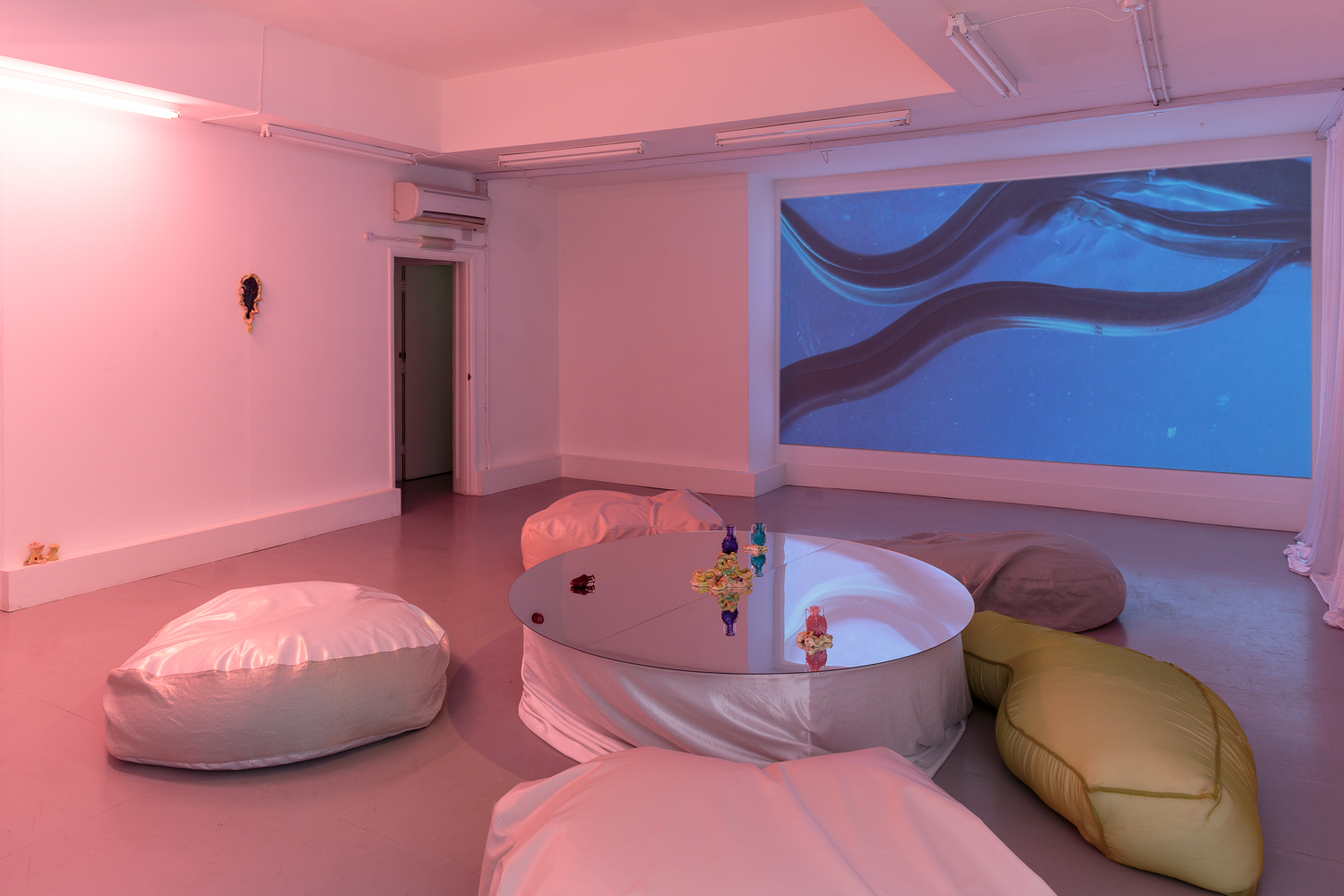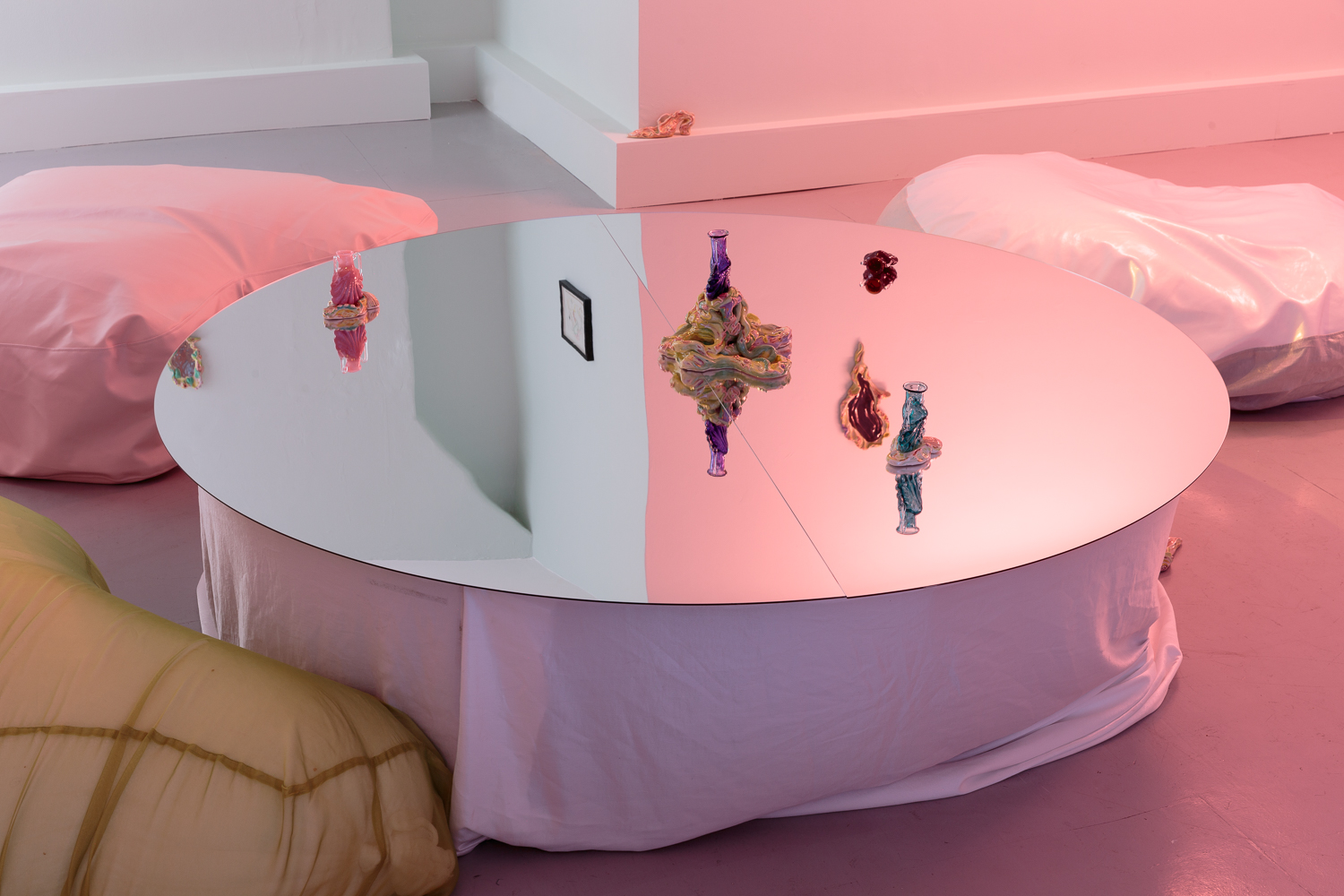Zoe Williams: Sunday Fantasy
OPENING 24 MAY
25 MAY – 27 JULY 2019
Solo exhibition and premiere of Zoe Williams’s new moving image work, Sunday Fantasy. Curated by Daria Khan
Daria Khan in conversation with Zoe Williams
DK: Your new film Sunday Fantasy uses a collaborative approach to filming : you invited 3 co-authors to create the film with you, so that each character could write their own script and realise their own fantasy. This approach requires a lot of trust and care, as each of you got to realise a sexual fantasy on camera, which can be quite vulnerable. Was it difficult to find people willing to join you in this experiment?
ZW: We are friends and have all worked together before on different projects, (both in a private and public context) stemming from our shared interest in exploring aspects of role play and notions of the erotic. Approaching it felt quite difficult. How do you represent people’s own agency properly and do it in a careful way, rather then trying to highjack their fantasy? So as someone who instigated it, I wasn’t the person who had power over those things. I just made a shell for things to be enacted in. I had this skeleton story about the bottle and about the objects we were going to move through the film with that would then be instigated in people’s fantasies; the fantasies of Deniz and Nadja; and to a certain extent Amy who worked on it more directly (we co-directed the film together). I was more an enabler, a set-designer, material-based, object-based, and Amy was i think coming from a more narrative building, film-making perspective. This perhaps plays more into her individual interest in being a voyeur and using the camera as a consuming tool with which to do this.
I asked Nadja and Deniz to come up with something not necessarily sexual, a fantasy they wanted to realise as part of this film and so they came up with these vignettes. Deniz has this phobia of eels and her character of this snake-eel woman, and then the eel imagery came through. It’s all on the edge of things being uncomfortable and grotesque.
DK: There is a feeling of trust and the atmosphere of non-judgement for the viewer, a safe space, not only inside the film but also outside of it. The female subjects in the film are really in control of their desire and pleasure, no matter if they choose dominant or submissive roles, besides that it’s much more ambivalent in the narrative, the positions easily switch in between.
ZW: Yeah I guess it's more trying to capture the fragmented way that you might experience fantasy and desire and how everyone experiences it so differently. When people talk about sexuality and the erotic, sometimes it can just overtake everything else that’s going on and make everything two-dimensional. There are always these other elements juxtaposed within that landscape that makes things much weirder. When you have a fantasy, desire or a dream it’s not a linear experience, or necessarily a palatable one.
DK: Besides playfulness and spontaneity, there is also the entitlement to pleasure that you feel from the characters. Entitlement you usually feel from men, while women appear as receivers of desire. The heroines of the film are self-sufficient in generating their desire and pleasure. For me it is powerful in that it resists female sexual archetypes as they are usually portrayed in erotic films.
ZW: There is definitely that, and trying not to fall into the role of pleaser. The piss running through - it’s this magical liquid. And the idea of excess, and decadence, and dressing up, and how these can be used as a weapon not as something to dress yourself up to be attractive but something that you want to embody.
DK: You have this reference to an early 90s aesthetics. Does this time represent something specific for you in terms of how eroticism was depicted?
ZW: “Basic Instinct” and “Showgirls”, might not be necessarily politically correct films but the female characters subvert what it means to be palatable females. I am not sure it was a totally conscious choice, but the 90s aesthetic perhaps has something to do with the fact that this was when our fantasy worlds began to build up as children and young adults. Those are some of the images that just stick with you.
DK: Objects in the films are endowed with power and autonomy. There is a mixture of artifice and nature: artefacts and consumer goods, shoes, dildos, insects, eels, food - all are intertwined and everything holds a potential of pleasure, forming this highly sexualised world. The core element of the film is the bottle with magical powers to induce erotic fantasies. It feels like a queer version of Genie’s bottle. What’s the story behind the bottle?
ZW: The original bottle is in the British museum, it’s a Roman perfume bottle and I’m interested in these early commodity objects and luxury production. I often think about the history behind objects, I did my dissertation on the history of the dildo, as this shifting totemic object. It reminds me of that somehow. I wanted this film to be a ridiculous fantasy, playing in an irreverent way with ideas of history: because the way histories are represented in museums generally come from a very patriarchal Western perspective. So I wanted to mess with this a bit, creating a fictional character of this lesbian Roman priestess who owned this bottle, in something that is akin to a 70s B-movie storyline. Who knows what’s the history and reality of this object? Either way It felt important for me to possess it, to make it the key in this film.
DK: Like re-animating it with an imaginary story.
ZW: Yeah with an imaginary, idealised, queered story. It also might have had a really horrible story.
DK: Like used for poison?
ZW: Yeah. It’s about the magical aspect of that. It was about the Veronica Malaise character who is this interchangeable woman that we all inhabit. This frustration you often feel as a woman trying to somehow realise your desires and to have them accepted. It’s like a freeing of that.
DK: I also thought about the faceless male character in the beginning of the film.
ZW: We took him out.
DK: Oh great!
ZW: We thought it wasn’t right, that we couldn’t have him.
***
Zoe Williams has worked with her friends and collaborators; Amy Gwatkin, Deniz Ünal and Nadja Voorham on the construction of the film, inviting them to enact their own and each other’s fantasies within it. The film is co-directed by filmmaker Amy Gwatkin, with a soundtrack by musician David Aird.
Zoe Williams (b.1983). Lives and works in London and is represented by Antoine Levi Gallery, Paris. Her practice incorporates a range of mediums including moving image, ceramics, drawing and performance. Through these elements she is primarily concerned with creating immersive instances and environments which, holding a veneer of seduction, seek to access the cerebral through sensual experience. Recent solo exhibitions include; The Unruly Glove, The Green Bum and The Sickly Trickle, Antoine Levi Gallery, Paris; Morsa, Studio Amaro, Naples; Pel, Antoine Levi Gallery, Paris; Soft Paste, The Studio Warehouse Gallery, Glasgow; The Flight of O, Spike Island, Bristol. Significant group projects include; (X) A Fantasy, group exhibition and performance commission, DRAF, London; Spring/Summer 2015, DCA, Dundee; The Chic and The Borderline, cur. by David Roberts Art Foundation, part of Art International Istanbul; Watch yourself, cur. by David Dale Gallery with Video Art Network Lagos and UK:NG Festival, Rele, Lagos; Mood is Made /Temperature Is Taken, GSS, Glasgow; Chateaux Double Wide, Glasgow International Festival 2016; H Y P E R C O N N E C T E D, MMOMA, part of 5th Moscow International Biennale of Young Artists; Mademoiselle, Centre Régional d’Art Contemporain Occitanie, Sète, France; The Armoury Show 2019, New York; Playful Aggressions, Greengrassi, London; Ruffles, Art Montecarlo 2019; Something soft, Kunstraum, London.
Generously supported by Arts Council England, GIRLPOWER Collection, Chakrubs, Davydov Bespoke, Barefoot Wine & Bubbly, Mayfair Art Weekend and Forest Recycling Project. With thanks to Rochester Square for making the production of the ceramic works possible.





































